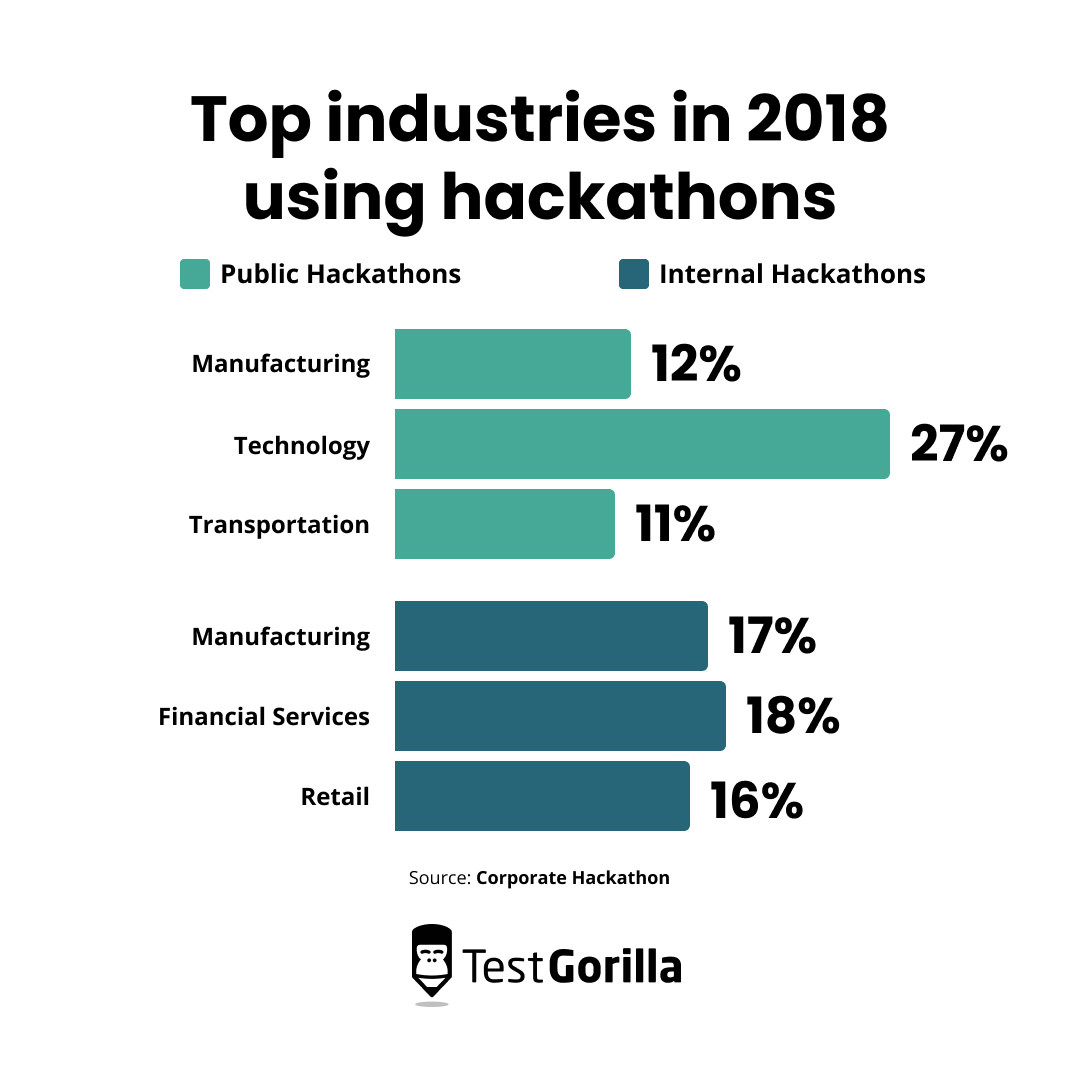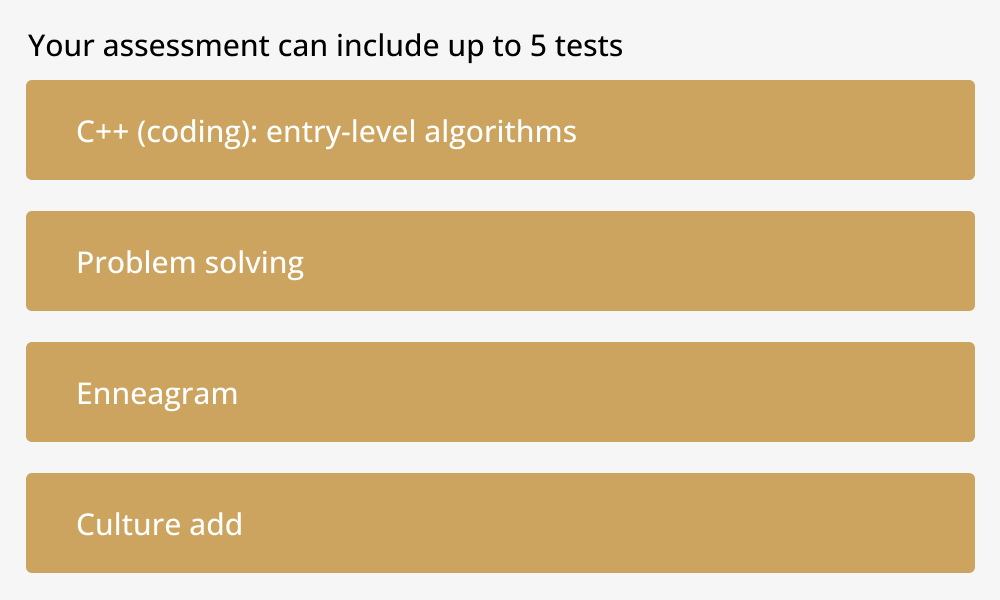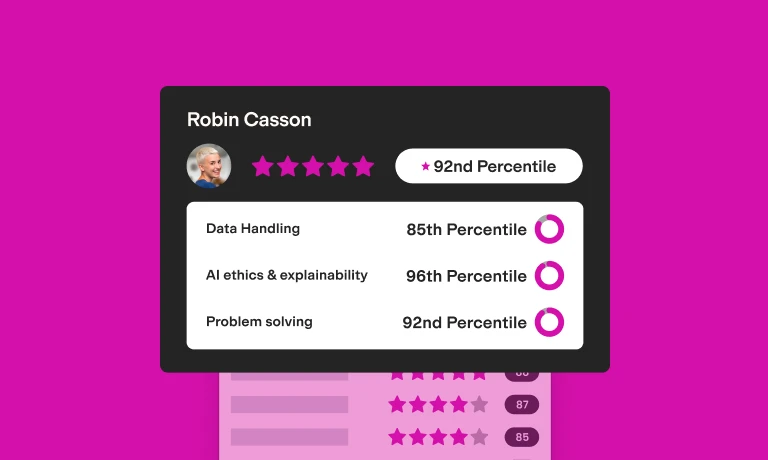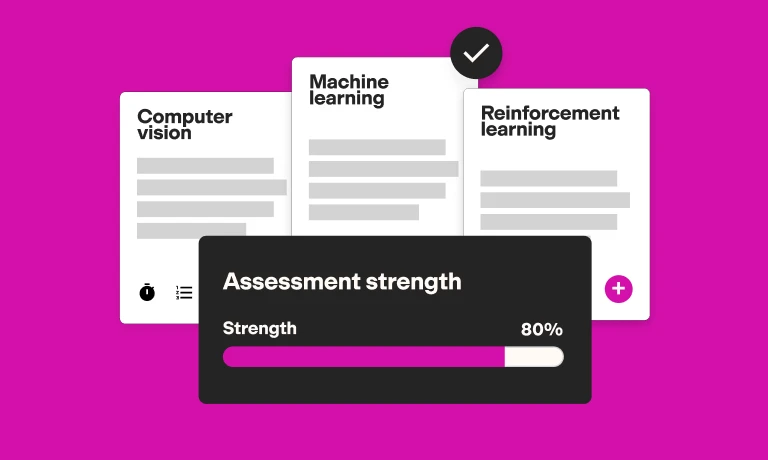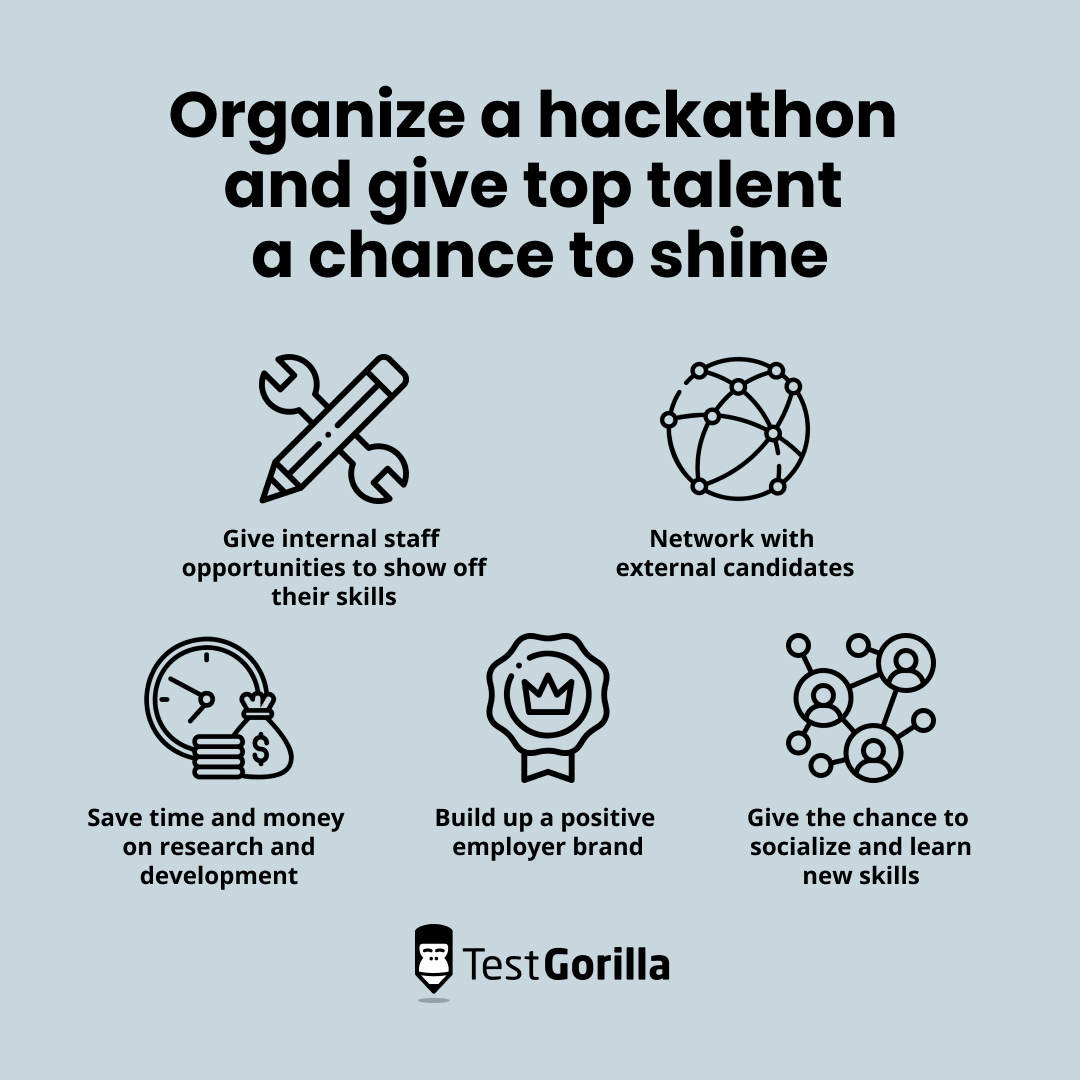Organize a hackathon: How to leverage this talent acquisition strategy
The global skills shortage is getting worse – especially in the tech industry. Seven out of 10 tech companies feel they lack the talent to keep up with their changing environment.[1]
Without specialized skills at the heart of your team, you risk losing revenue and facing obsolescence.
Organizing a hackathon is just what you need to breathe new life into your firm – it’s a chance to bring top talent together on exciting and innovative projects.
When you organize a hackathon effectively, you:
Promote your company and attract top talent
Boost in-house collaboration and employee engagement
Assess existing employee skills, such as motivation and advanced Scala
Solve complex problems at a cost fraction
In this guide, we examine hackathons in detail, explore the best ways you can use this talent acquisition strategy, and share some successful hackathon examples.
If you already know how to plan a hackathon, jump ahead to our best practice tips.
Table of contents
- What is a hackathon?
- Why is organizing a hackathon important?
- The benefits of organizing a hackathon
- How to organize a hackathon: 8 best practices for acquiring top talent with this talent acquisition strategy
- Hackathon examples: 3 companies succeeding with hackathons as a talent acquisition strategy
- Organize a hackathon and give top talent a chance to shine
What is a hackathon?
A hackathon is a collaborative event where professionals innovate products and solve problems. It's an ideation or brainstorming session that typically takes place over a set period and pushes participants to show off their knowledge and talent.
Hackathons are usually tech-oriented, most often welcoming hackers, engineers, programmers, software developers, and IT experts.
That said, hackathons are a bit of a talent acquisition trend outside of the tech industry. Some hackathons, for instance, tackle social issues and consumer impacts rather than solve technological problems.
Research suggests that manufacturing, transportation, financial, and retail industries all use hackathons.[2]
It’s not just companies and startups hosting hackathons. Institutions, such as the European Commission, are also known to host data hackathons, bringing together teams from across the continent.
Examples of hackathon projects could include:
Building an app
Designing a toy or game
Setting up a website or marketplace
Finding ways for AI to help people
Companies set up hackathons to bring together in-house staff or invite potential hires to work on projects. For the business, it's an opportunity to expand its talent pool and empower individuals to network and flex their expertise.
Different types of hackathon
Hackathons generally fall into one of five categories:
Internal hackathons
External hackathons
Onsite hackathons
Online or virtual hackathons
Hybrid hackathons
Let’s quickly break these down.
1. Internal hackathons
Internal hackathons occur in-house between current employees to find existing talent and help people build teamwork and problem-solving skills.
2. External hackathons
External hackathons involve non-employee participants (outside a company) to find new talent and introduce people to a talent pool.
3. Offline hackathons
Offline hackathons bring people together in a single venue or physical location where they can interact with each other in person and face-to-face.
4. Online or virtual hackathons
Online hackathons encourage people to work together from afar using specialist software, video conferencing, and Slack or Microsoft Teams channels.
5. Hybrid hackathons
Hybrid hackathons blend online and offline models, meaning people can choose to work at a specific location together with others or online from afar.
Internal and external hackathons can take place online, onsite, or through a hybrid model. Online hackathons generally work well for external events because they are flexible for anyone to take part in, regardless of location.
Hackathons can be competitive, collaborative, or a blend of the two via team-based competitions.
Why is organizing a hackathon important?
Hackathons are beneficial for employers, internal staff, and potential candidates.
Let’s explore how and why.
Why employers should organize a hackathon
Hackathons enable employers to show off the types of projects they specialize in and their good company cultures.
External hackathons, for example, help candidates get closer to a prospective employer and understand their values. They also gain insight into their work and how performance is measured.
Companies might wish to promote their CSR strategy, to show their spirit for innovation, or to assure their commitment to solving specific problems. All in all, a hackathon is a fantastic opportunity to build employer branding.
Internal hackathons, on the other, give employers additional insight into their staff – i.e., they learn about their power skills and where they could support the company further.
Why employees should take part in hackathons
Hackathons are exciting social events where people can solve puzzles and network. It's also a chance for experts to extend their professional networks and spot upskilling and reskilling opportunities.
People joining external hackathons gain insight into how companies operate, meaning it’s more than just positive PR from the business side.
Internal hackathons present a chance for staff to work more closely with coworkers and develop teamwork skills. In team-based hackathon activities, staff gain insight into the strengths of others and, therefore, can use this information on future projects.
The best insights on HR and recruitment, delivered to your inbox.
Biweekly updates. No spam. Unsubscribe any time.
The benefits of organizing a hackathon
When organizing a hackathon to boost recruitment for your firm, you:
Gain positive exposure for your company
Solve problems and launch products cost-effectively
Attract experts into talent pools
Closely assess candidate skills
Let’s examine each of these benefits in a little more detail.
1. Gain positive exposure for your company
Hackathons are "crowdsourcing" projects that bring experts on board for large-scale brainstorming sessions and promote a company's drive to solve specific problems.
A good example of a hackathon used to expose innovation and values was Walmart's Internal Virtual event, where 54 employees created 13 projects over two days to help promote the superstore's sustainability initiatives.
Although this was an internal event, the company showed the wider market its willingness to innovate and its commitment to sustainability.[3]
Hackathons also work well as part of employer branding for external candidates and passive hires because they demonstrate how willing companies are to disrupt traditional ways of working.
Hackathons further help businesses capitalize on trending topics and new technology – and get involved with ideas generating buzz in their industries.
2. Solve problems and launch products cost-effectively
Hackathons help companies identify which tools produce the best results for their projects and narrow down potentially costly decisions.
Feedback from people participating in an internal hackathon gives insight into what your projects and products need the most.
Consider a hackathon much like a demo exploration. It's a dry run for a project or a product line that could prevent pricey mistakes.
Let's look at an app creation hackathon as an example – you could close the contest with various proofs of concept or working prototypes for a future app that is almost ready to launch. Therefore, you don't need to spend a lot of additional money on research and development.
Hackathons help companies solve multiple problems at once, condensing costly research and development into short events.
3. Attract experts into talent pools
Building talent pools is a reliable way to ensure you have expertise available during high-volume hiring and skills shortages.
Unlike talent pipelines, where a prospective employee is already warmed up for you to contact, talent pools are broad networks of people you could pitch to should roles open up.
Regardless of the outcome of your hackathon, you get to see how various people perform on tasks and challenges you set.
By designing hackathon challenges that tie carefully into the everyday demands of your company, you can see how prospects work with others and how they solve problems relevant to your business.
Although you might not recruit people directly from your hackathon, you at least have high performers you can add to your database.
Hackathons support passive recruiting – hiring people who aren’t actively applying for work. Some of these candidates take part purely for the prizes or the thrill of the challenge but now have an idea of what to expect from you should job roles arise.
4. Assess candidate skills
Internal hackathons enable your staff to explore and build upon skills they don’t frequently use in their everyday work.
As an organizer and stakeholder, it’s a good opportunity to observe their different skills and techniques.
What’s more, assessing skills helps you move people to other areas where they might be more supportive and where there are learning and development opportunities with mentors.
Testing skills through external events helps you organize your talent pool so you know who to approach when hiring.
Consider assessing the skills of the most promising hackathon participants – internally or externally – by asking them to complete talent assessment tests.
How to organize a hackathon: 8 best practices for acquiring top talent with this talent acquisition strategy
In this section, we cover eight tips you should keep in mind when organizing a successful hackathon. They’re applicable regardless if you’re planning your first-ever hackathon or if you're looking for new ways to leverage talent during your next contest.
Top tips for your hackathon planning checklist
Best practice | Quick summary |
1. Clearly outline your goals | Show participants the main aims of your event so they know what skills you’re looking for |
2. Be clear on the process | Create a fair and level playing field to remove doubt and appeal to more applicants |
3. Evaluate attendees with talent assessments | Test for skills during your event to help sort your talent pool for future recruitment |
4. Attract tech professionals from a broad range of backgrounds | Be explicit about making your hackathons accessible to all |
5. Encourage innovation with culture add testing | Test for culture add to measure how people potentially add to your team, not just how technically proficient they are |
6. Promote your hackathon | Use various promotional tools online and offline to encourage participation, such as recruitment marketing |
7. Leverage your internal hackathon as a training initiative | Design your event as a preboarding exercise for anyone interested in applying with you – and save time on eventual training |
8. Add hackathon perks | Offer prizes for participation and top projects to encourage applications |
1. Clearly outline your goals
A successful hackathon has a clear theme, specific topics, location, rules, and target audience. However, you need to ensure your participants know what to aim for.
Set a goal for yourself as the organizer and for your participants. For instance, your goal could be to “find talented AI engineers for our talent pool.”
Use this goal to build a creative way for participants to show they meet your expectations.
Ask them to create an AI app that enables users to speak to people from history, for example. Alternatively, they could build culinary apps that learn about user tastes and preferences, suggesting recipes and ingredient ideas.
Clear goals ensure your participants know what to aim for and the skill sets and techniques you’re interested in seeing them show off. You get a clear picture of how participants align with your hackathon theme or goal, and they feel more confident taking part in the meetup.
When learning how to organize a virtual hackathon, prioritize laying out your goals via online marketing in advance.
2. Be clear on the process
Always ensure your participants know the rules and judging criteria of your hackathon before they start.
Make these rules clear through your online and offline communication.
Are you hosting an internal or external hackathon? Onsite or online? Consider whether you'd like to attract external talent or dig deep into your internal skills pool.
Here are a few quick tips to consider:
Offset impostor syndrome by making it clear your event is a level playing field
Keep your event simple and decide whether or not you’re going to let people form teams and choose team members
Set a time limit you feel is fair yet challenging enough for the best talent you're looking to acquire
3. Evaluate attendees with talent assessments
Although participants show their skills by competing in your hackathon, using talent assessments gives you extra confidence when measuring the abilities of people taking part.
What’s more, skills testing helps you to organize your talent pool for proactive recruitment in the future. Think about organizing and segmenting participants based on their technical skill and personality scores, for example, and cross-reference this data during future drives.
Relying on people to show you their skills in hackathons can help you understand how they work under pressure. However, there might be other skills you’d like to test for but can’t adapt to the format of a hackathon – that’s when you should turn to talent assessments either before or after the event.
4. Attract tech professionals from a broad range of backgrounds
The more accessible your external hackathon is, the broader your participant pool becomes.
Consider organizing an online hackathon to appeal to diverse candidates with physical restrictions, such as working parents, students, and people with disabilities.
This virtual hackathon appeals to remote employees looking for opportunities without attending a physical office and to neurodivergent people looking for psychological safety.
Recruiting from a wider pool by breaking down access barriers helps to show your company has inclusive hiring policies and cares about those who struggle to find opportunities elsewhere.
5. Encourage innovation with culture add testing
Culture add testing your participants before they join gives you insight into how certain people work and the innovation they can bring.
Think about using a Culture Add test to understand how your participants add to your team and your values.
This way, you’re not just relying on technical expertise and experience; you’re also focusing on their thirst for innovation and their approach to teamwork.
Here’s what a custom test for a game programmer, including culture add and technical assessments, looks like in TestGorilla’s builder:
6. Promote your hackathon
No one’s coming to your hackathon unless you promote it, so consider using social media recruiting strategies to reach people across different professional networks.
The same applies to internal events – spread the word company-wide.
Externally, promote hackathons as part of your recruitment marketing strategy. Focus on promoting them as exciting events with no job strings attached.
Blast news to employees on your local intranet and Slack channels. Email people subscribed to your newsletters, ask employees to refer people in their professional networks, and consider promoting hackathons via virtual job fairs or campus recruitment drives.
This last point is particularly important because hackathons are exciting ways to encourage graduates to get a taste of what you do, help them prove themselves, and potentially join internships if successful.
7. Leverage your internal hackathon as a training initiative
Depending on the scope of your event and the goals you set, you could use your hackathon to take care of some of the training sessions they’d expect as an employee.
Consider this a perk for you and your participants. By incorporating training into your hackathon, you cut down the time you’d spend on training staff on other occasions.
For example, look into introducing people to a specific software during the hackathon – it's a reliable way to test learning capabilities, flexibility, and skills under pressure.
You can also use this tactic when organizing a hackathon for high-value external candidates, i.e., senior developers. By taking this skills-first approach, you show them you’re committed to a strong candidate experience, and you’re the perfect place to develop their career further.
8. Add hackathon perks
Consider offering more than just “entering the talent pool” as a perk for joining and doing well in hackathons.
People love prizes! Offer participation awards so there are benefits simply for participating, but prioritize first-prize winners in team and individual competition formats. Look into tangible rewards, such as gift certificates or tech devices (like laptops or smartphones).
Alternatively, squeeze extra value from your hackathon by offering prizes and swag tied to your company.
You could even prioritize winning teams for your internship program or a financial stipend for those who want to work remotely with you. A hands-on experience day works well when combined with a follow-up incentive.
Hackathon examples: 3 companies succeeding with hackathons as a talent acquisition strategy
Let's look at some successful hackathons and the benefits that arose for the companies that organized them.
Successful hackathon ideas to inspire you
Hackathon example | Why it’s inspiring |
Landing.Jobs | The company held an external hackathon event and attracted a wide field of applicants with large prizes. It gained useful insight into how to present its data better. |
Courier | The firm uses hackathons regularly to improve customer innovations and team cohesion; some winning ideas are now product templates. |
Amazon | This leader in e-commerce encouraged female coders in India to take part in an International Women’s Day challenge, raising awareness of female coding expertise and attaching a recruitment funnel. |
Landing.Jobs
Landing.Jobs, a job marketplace for tech professionals, launched a "Data Challenge" to help strengthen its annual Tech Careers Report. The report offers insight into Portugal's tech industry – and this hackathon invited people to find new ways of analyzing its data and improving its insights.
This community project offered prizes worth more than $1,800 and welcomed 14 projects from 142 participants. It was open to graduates, students, data scientists, innovators, and people generally interested in data wrangling.
This online, external challenge saw a number of participants download raw data and apply their own processes to develop analytical reports.
The event resulted in the firm gaining insight into new ways to work with data for its future annual releases.
The event helped to empower the data community, not just data scientists, giving a broad audience a chance to flex their skills and techniques.[4]
Courier
Courier, a notification organization platform, uses internal hackathons to help develop product ideas.
The company's main aim with hackathon events is to improve its customer experience and product line. However, it further claims that its events have helped staff to engage better with each other.
The company's first hackathon requested employees to develop an idea to help its clients embed product functionalities in their websites.
This event's winning idea was a component that enables people to directly manage notifications when browsing client websites.
Courier’s hackathons have produced features that are now popular with the firm’s customers and have inspired its developers to build further useful components.[5]
Amazon
Amazon reports that using hackathons with skills testing has helped it appeal to female coding talent.
Marketing its hackathon around International Women’s Day, the company ran an online event with a coding simulator and test library to help test the skills of people taking part.
The firm blended its coding challenge with a recruitment push, leading in with a landing page funnel before presenting the hackathon to women who wished to participate.
The company then used data pulled from the skills tests and coding results to set up interviews.
As a result, 6,500 female students across India took part in the event, raising awareness of the low female representation in the tech industry and, at the same time, helping to streamline the firm's assessment and recruitment process.
This example shows that hackathons can help transform long-term processes and produce immediate, positive PR.[6]
Organize a hackathon and give top talent a chance to shine
In an industry plagued by skills shortages, hackathons give tech companies and professionals exciting opportunities to innovate and collaborate.
As a hackathon organizer, you benefit from a talent acquisition strategy that promotes your thirst for innovation – and empowers you to reach more diverse audiences.
When organizing a hackathon effectively, you:
Give internal staff opportunities to show off their skills
Network with external candidates
Save time and money on research and development
Build up a positive employer brand
Give tech talent the chance to socialize and learn new skills
Hackathons and talent assessment tests work together to broaden your recruitment scope and fill the most urgent skill gaps.
Before planning a hackathon, learn more about what makes an appealing corporate identity.
When you’re ready to explore skills-based hiring further, head to the TestGorilla library and browse more than 300 assessments that are ready to customize.
Sources
“Nash Squared Digital Leadership Report 2022”. (2022). Nash Squared. Retrieved September 17, 2023. https://assets.website-files.com/626a518e6507e342004ee1fe/6362a0d554337f1765c0ee16_Nash%20Squared%20Digital%20Leadership%20Report%202022_FINAL.pdf
“Corporate Hackathon 2018 - 2019 Trends”. (2019). Hackathon Infographic. Retrieved September 17, 2023. https://corporate.hackathon.com/infographic-2018
“Case Studies From Blue Chip Clients”. Hackathon.com. Retrieved September 17, 2023. https://corporate.hackathon.com/use-cases
“Landing.Jobs Data Challenge”. TAIKAI. Retrieved September 17, 2023. https://taikai.network/landingjobs/hackathons/datachallenge/overview
Napier, Riley. (January 13, 2022). “How We Use Internal Hackathons to Create New Product Features”. Courier. Retrieved September 17, 2023. https://www.courier.com/blog/internal-hackathons-product-features/
“Enabling diversity hiring”. Mettl. Retrieved September 17, 2023. https://mettl.com/clients/leading-ecommerce-player/
You've scrolled this far
Why not try TestGorilla for free, and see what happens when you put skills first.


